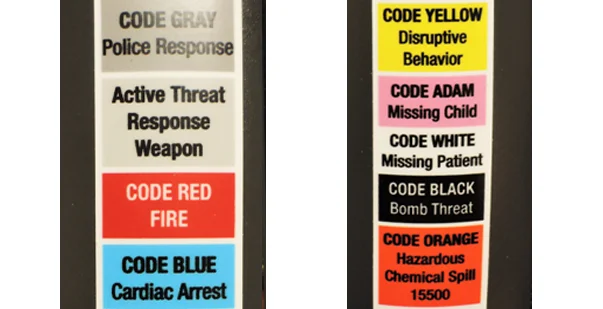
Last Updated on: August 1, 2024
Table of Content(s)
Universal Hospital Emergency Codes are a set of color-coded emergency signals that hospitals use to convey essential information. These ensure prompt responses to emergencies. It reduces confusion and ensures that staff work together in high-stress situations. The codes are usually displayed on posters. Staff members are trained to recognize the signs and respond promptly.
Universal hospital codes efficiently communicate all information during medical emergencies. Each code has a unique color, which represents an emergency. This requires immediate action. Here are a few common hospital codes:
A cardiac arrest occurs when the beating of the heart stops. A respiratory arrest is when breathing stops. In both of these cases, patients need immediate treatment to prevent serious injury. When a respiratory arrest is suspected, it is crucial to begin resuscitation as soon as possible. This will help you restore blood flow and bring breathing back to its normal state.
Read more: When To Stop Performing CPR?
Resuscitation is an emergency procedure that can save the life of a person whose breathing has stopped. Here are some easy steps to resuscitate:
Read more: Depth Compression: How Deep Should CPR Chest Compressions Be?
This pneumonic represents the order of priority for interventions during an emergency. This is the order in which interventions are performed. It may vary depending on the situation.
A-B-C-D stands for airway, breathing, circulation, and defibrillation. The first priority is to maintain and establish an open airway. This will ensure that the patient can breathe well. This addresses any issues associated with circulation. Defibrillation restores a normal heart rhythm.
These interventions must be performed simultaneously, based on the needs and situation of the patient.
This mnemonic stands for support, oxygenation, airway, and pump.
This helps healthcare professionals easily remember the priority of interventions.
What is code black in a hospital? Code black means a bomb threat or an active shooter situation. This code is a signal for hospital staff to take immediate action and protect themselves from harm or injury. The procedures may vary between hospitals. However, hospital staff follow the protocols by evacuating patients and making the place secure. The code ensures the safety and security of everyone in the hospital. This helps prevent any harm or injury to individuals or the facility.
The acronyms are used during emergencies, especially those involving violent threats. Follow these steps in the case of code black:
So what is code yellow in a hospital? Code yellow is common in situations where a patient or a visitor goes missing. The code alerts the hospital staff, and a search is conducted to find the missing person. During a code yellow in hospital, hospital staff notifies the security panel and all departments. This increases the chances of finding the missing person effectively.
Code green in hospital indicates an external disaster that affects the hospital, such as a hurricane or tornado. This is activated by hospital administrators during a natural disaster. When a code green is initiated, hospital staff must follow the hospital’s emergency response plan. This involves several procedures that protect staff from any hazardous event.
I-M-P-A-C-T: This is used in emergency response situations. It stands for the following:
Identify, mobilize, plan, assess, triage, and communicate.
The steps identify the emergency, mobilize resources, and develop an action plan with responsibilities and roles. It assesses and adjusts the plan and communicates with the parties involved.
S-U-R-G-E: This acronym is beneficial for remembering key elements while setting up a living space. It includes the following:
Code gray describes a situation involving a violent person who may pose a threat to visitors or patients. When this code is activated, hospital staff will follow the procedures and ensure the safety of all. The procedures may include locking down areas of the hospital and moving patients to safe areas.
C-A-R-E
This is used in code-gray scenarios. These are situations that involve violent patients. The steps involve:
P-R-E-V-A-I-L
This acronym is used to remember the steps of an active threat response. It stands for the following:
The future of Universal Hospital Emergency Codes involves continued efforts and increased adaptability to diverse healthcare settings. Collaboration with emergency services and ongoing education will shape the evolution of hospital code settings. Study the codes well to respond promptly during any emergency.